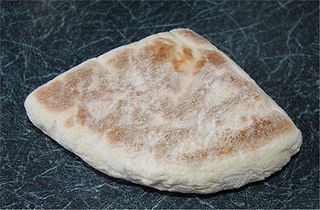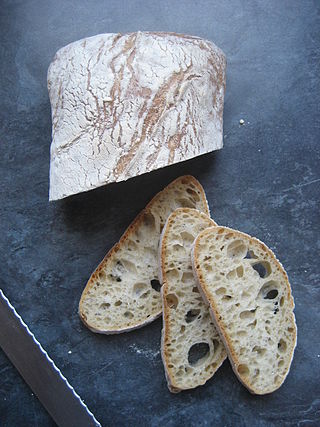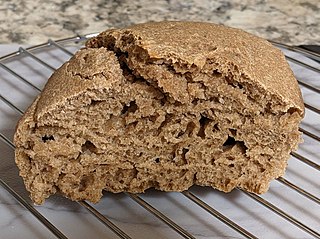Related Research Articles

Bread is a staple food prepared from a dough of flour and water, usually by baking. Throughout recorded history and around the world, it has been an important part of many cultures' diet. It is one of the oldest human-made foods, having been of significance since the dawn of agriculture, and plays an essential role in both religious rituals and secular culture.

Cake is a flour confection made from flour, sugar, and other ingredients and is usually baked. In their oldest forms, cakes were modifications of bread, but cakes now cover a wide range of preparations that can be simple or elaborate and which share features with desserts such as pastries, meringues, custards, and pies.

Chapati, also known as roti, rooti, rotee rotli, rotta, safati, shabaati, phulka, chapo, sada roti, poli, and roshi, is an unleavened flatbread originating from the Indian subcontinent and is a staple in India, Nepal, Bangladesh, Pakistan, Kyrgyzstan, Sri Lanka, the Arabian Peninsula, East Africa, and the Caribbean. Chapatis are made of whole-wheat flour known as atta, mixed into dough with water, oil (optional), and salt (optional) in a mixing utensil called a parat, and are cooked on a tava.

Dough is a thick, malleable, sometimes elastic paste made from grains or from leguminous or chestnut crops. Dough is typically made by mixing flour with a small amount of water or other liquid and sometimes includes yeast or other leavening agents, as well as ingredients such as fats or flavorings.

Christmas pudding is sweet, dried-fruit pudding traditionally served as part of Christmas dinner in Britain and other countries to which the tradition has been exported. It has its origins in medieval England, with early recipes making use of dried fruit, suet, breadcrumbs, flour, eggs and spice, along with liquid such as milk or fortified wine. Later, recipes became more elaborate. In 1845, cookery writer Eliza Acton wrote the first recipe for a dish actually called "Christmas pudding".

Soda bread is a variety of quick bread made in many cuisines in which sodium bicarbonate is used as a leavening agent instead of yeast. The basic ingredients of soda bread are flour, baking soda, salt, and buttermilk. The buttermilk contains lactic acid, which reacts with the baking soda to form bubbles of carbon dioxide. Other ingredients can be added, such as butter, egg, raisins, or nuts. Quick breads can be prepared quickly and reliably, without requiring the time and labor needed for kneaded yeast breads.

Pakora is a fritter originating from the Indian subcontinent. They are sold by street vendors and served in restaurants in South Asia. It consists of ingredients, often vegetables such as potatoes and onions, coated in seasoned gram flour batter and deep fried.

Ciabatta is an Italian white bread created in 1982 by a baker in Adria, province of Rovigo, Veneto, in response to the popularity of French baguettes. Ciabatta is somewhat elongated, broad, and flat, and is baked in many variations, although unique for its alveolar holes. Ciabatta is made with a strong flour and uses a very high hydration dough.

The germ of a cereal grain is the part that develops into a plant; it is the seed embryo. Along with bran, germ is often a by-product of the milling that produces refined grain products. Cereal grains and their components, such as wheat germ oil, rice bran oil, and maize bran, may be used as a source from which vegetable oil is extracted, or used directly as a food ingredient. The germ is retained as an integral part of whole-grain foods. Non-whole grain methods of milling are intended to isolate the endosperm, which is ground into flour, with removal of both the husk (bran) and the germ. Removal of bran produces a flour with a white rather than a brown color and eliminates fiber. The germ is rich in polyunsaturated fats and so germ removal improves the storage qualities of flour.

Potato bread is a form of bread in which potato flour or potato replaces a portion of the regular wheat flour. It is cooked in a variety of ways, including baking it on a hot griddle or pan, or in an oven. It may be leavened or unleavened, and may have a variety of other ingredients baked into it. The ratio of potato to wheat flour varies significantly from recipe to recipe, with some recipes having a majority of potato, and others having a majority of wheat flour. Some recipes call for mashed potatoes, with others calling for dehydrated potato flakes. It is available as a commercial product in many countries, with similar variations in ingredients, cooking methods, and other variables.

Frybread is a dish of the indigenous people of North America that is a flat dough bread, fried or deep-fried in oil, shortening, or lard.

Cinnamon sugar is a mixture of ground cinnamon and granulated sugar used as a spice to flavor foods such as Belgian waffles, Snickerdoodle cookies, tortillas, coffee cake, French toast, and churros. It is also used to flavor apples, cereals, and other fruits. As McCormick describes cinnamon sugar, "it’s the comforting scent of Sunday morning cinnamon toast and mid-summer’s peach cobbler...the aroma of the holidays, with cinnamon cookies and spice cake."
Clive Maine McCay was an American biochemist, nutritionist and gerontologist.

No-knead bread is a method of bread baking that uses a very long fermentation (rising) time instead of kneading to form the gluten strands that give the bread its texture. It is characterized by a low yeast content and a very wet dough.

Barley flour is a flour prepared from dried and ground barley. Barley flour is used to prepare barley bread and other breads, such as flat bread and yeast breads.

Tamale pie is a pie and casserole dish in the cuisine of the Southwestern United States. It is prepared with a cornmeal crust and ingredients typically used in tamales. It has been described as a comfort food. The dish, invented sometime in the early 1900s in the United States, may have originated in Texas, and its first known published recipe dates to 1911.

English Bread and Yeast Cookery is an English cookery book by Elizabeth David, first published in 1977. The work consists of a history of bread-making in England, improvements to the process developed in Europe, an examination of the ingredients used and recipes of different types of bread.

Batter bread is bread made with a substantial liquid-to-flour ratio, so that the dough is a batter. It is known for its ease of preparation.
References
- ↑ "Whole Wheat Bread Recipe: McCay's Miracle Loaf". Mother Earth News . Retrieved January 3, 2016.
- 1 2 Hensperger, Beth (2000). The bread lover's bread machine cookbook: a master baker's 300 favorite recipes for perfect-every-time bread, from every kind of machine. Boston, Mass: Harvard Common Press. ISBN 978-1-55832-155-7.
- ↑ Brody, Jane E. (1985). Jane Brody's Good Food Book: Living the High-carbohydrate Way. Norton. ISBN 9780393022100.
- ↑ Office of Web Communications, Cornell University. "Cornell University - Search Cornell" . Retrieved 3 January 2016.